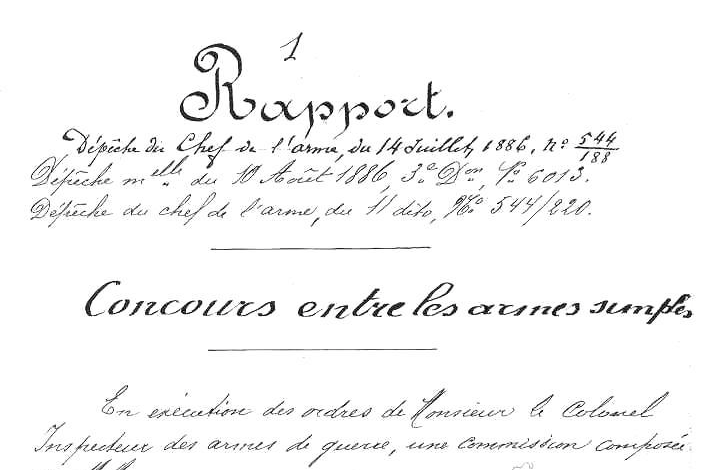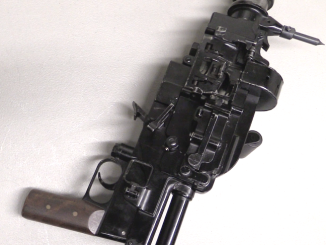The Hovea m/49 was adopted by Denmark, but was originally designed by Huqvarna for Swedish military trials. The first 10 prototype were made in 1944 and competed against the Carl Gustav Stads design – which ultimately won and was adopted by Sweden as the m/45. Both designs were very similar; simple blowback, open bolt, and made from tube and stampings.
Denmark adopted the Husqvarna design in 1949 as the Hovea m/49, with production licensed to a Danish state firm in Copenhagen. While this and the m/45 are very similar, the Hovea has the capability to use Suomi drums – which the m/45 does not. That appears to have been a significant factor in the Danish choice, although in service they initially used Finnish quad-stank magazine before switching to the more reliable Swedish double-stack m/45 box type.
A total of 15,750 m/49s were made, with an initial batch of 750 in 1950 and a main production run of 15,000 in 1952. It remained in Danish service into the 1990s, when it was replaced by the Diemaco C7 and the Hoveas were given to Lithuania.




“Quad Stank”?
Lol, yeah, that’s just the beginning of the typos if you read these posts every day. Apparently proof reading is a dead art. I blame autocorrect.
https://archive.org/details/con00ciseoxforddicfowlrich claims that stank is synonym for STINK.
Therefore I conclude above mean said magazine stink 4 or more (quad) compared to older magazines.
Just in case somebody’s not joking, please be aware that stank in this case is a typographical error for stack.
While original Swedish K’s did not accept Suomi drums, they are easily modified to do so. Mine runs great with both drums and quads.
According to https://www.smallarmsreview.com/display.article.cfm?idarticles=3261
It’s been written in the popular gun press that the Carl Gustav M45 will also take soumi drums- Not so. Only if one spends a day grinding and relocating the rear lug of the drum will it interface with the M45.
“(…)first 10 prototype were made in 1944(…)”
Photos of prototype could be seen here http://www.gotavapen.se/gota/artiklar/kpist/swede_45.htm in Trials for a new Submachine gun. chapter
Well, I would beg to disagree – my Kpist sans funnel takes drums, including the 40-rd drums, and I have never touched it with any file, not for half a day, but even half a minute for that matter. Anyway, this is out of the context anyway, as ONLY the Finns issued drum magazines, while the Swedish, the Danes, and the Swiss ONLY used quad-stacks (or coffin-mags, as the Finnish called them) – and then went to 36-rd wedge section stick (except for the Swiss, who stayed with the coffins into the 1990s). So the question whether Hovea or Swedish K would take drums by itself or not, is completely moot – except for the recreational users. But they all (Suomis, KP-44s, Swedish Ks, Hoveas, Port Saids, Aqabas etc) run better on 36-ers anyway. Only the KP-44 needs a slight prod with a Dremel cutter to take a 36.
PLUS, you can use Swedish rapid loaders and a 36-rd stripper clip to replenish them, which is great fun by itself.
BTW, the MP on a Fyrra Niy (Forty Nine – as this was reportedly called by the Danes) is for Maskinpistol, not Maschinen Pistol.
And, for the umpfteenth time: drums were Finnish, quads were Swedish. Some quads (late in war, replacing the MUCH heavier and more expensive drums) were manufactured in Tikkakoski, but no drums were ever made in Sweden. WHY ON EARTH you keep repeating “Finnish quads” and “Swedish drums”? And “Danish drums”?? They NEVER used drums, neither on their Madsen-Suomi MP M/41s, not on their Swedish-made MP M/44 Suomis. Just that some SMG takes a magazine, doesn’t mean it was ever used with one. The Egyptian Port Said was a licensed copy of the early Swedish K, down to pinned-on/off magazine funnel and side openings underneath for the quads and drums – but was ONLY ever ISSUED with 36-ers, never used with any others. UNTIL that is, they were phased out and bought by the WHATWOULDTHISBUTTONDO crowd…
You are right about everything else, but the quad stack “coffin” magazines were manufactured in Finland earlier than “late in war”. They were of course, as you wrote, of Swedish design. If I remember correctly, manufacturing was started in 1941 and continued until 1943 only, at which point it was abandoned. Manufacturing of drums continued all the way until the end of the war. Finnish soldiers usually preferred the drums despite their weight, since they did not need a loading tool and were generally reliable in use. The quads could not be loaded to anywhere near their theoretical capacity, if reliability was desired, and even when loaded to 35-40 cartridges only still had some reliability issues.
The quads were actually mostly discarded after the 36-er became available for Finland in the 1950s, which is why you don’t often see it in Finnish war movies for example. There was not many around when Suomi SMGs were sold for private ownership. Also I have heard from people who received training on the Suomi during the Cold War that they never even saw any “coffin” mags or received any training in their use.
Not related to SMG’s, but today’s online version of the Economist Magazine has an article about how some Ukrainian units are currently using Russian built Maxim M1910 machine guns that Ukraine still has in inventory. In fixed positions they are more effective then the Russian PKM; accurate to 1000M, effective to 3000M and capable of sustained fire. The Browning M2 must be the only other military weapon that has had as long a lifespan.
Pictures of Mosins being used are coming out of Ukraine – 1891.
Finnish military is still using sniper rifles built around Mosin receivers, some of which date back to the 1890s. The Finns must still have wagonloads of captured Mosin parts ….
https://en.wikipedia.org/wiki/7.62_Tkiv_85
Soon to be replaced, though, by a new 7.62 NATO semi-auto rifle designed by Sako, which will be based on the AR-10:
https://maavoimat.fi/-/uusi-kivaarijarjestelma-taydentaa-jalkavaen-vaikuttamiskykya?languageId=en_US
The Browning M2 must be the only other military weapon that has had as long a lifespan.
Maxim – 1884 (Russian – 1910) vs Browning 50 cal – 1921 (M2 1933)
“(…)Russian – 1910(…)”
I must note Russian Empire adopted Maxim machine gun earlier (in 1901, bought from Great Britain) produced domestically since 1904, 1910 is upgraded version of former one.
“(…)Browning M2 must be the only other military weapon that has had as long a lifespan(…)”
I protest, as if you are comparing against first version, it is inferior to Lee-Enfield https://en.wikipedia.org/wiki/Lee%E2%80%93Enfield#Contemporary_service
Maxim guns especially of the PM1910 variety have shown up during all the wars following the dissolution of the USSR. Not surprising as the soviets kept really big war reserves and the PM1910 was manufactured all through to the end of the great patriotic war. The metal belts of the PKM fit these and as long as you do not have to carry it, it is a very reliable machine gun with lots of firepower in a fixed position or on a “technical”.
Prøv at sæt nogle batterier bag ende dækslet. Det gjorde soldaterne når deres overordnet ikke var til stede. Så skød den vildt hurtigt. Hvis du får muligheden for det.
Try putting some batteries behind the end cover. The soldiers did so when their superior was not present. Then it shot wildly fast. If you get the chance.
here you can see what it looked like in Danish use
https://m.youtube.com/watch?v=rjCyr8jeOsw
Hilsen
Karsten
Daft question about the magazine wells on the Hovea, Suomi and the Carl Gustav,
The guide ribs on the backs of the magazines and the channels on the gun, all seem to be a very close fit
Inserting a magazine seems to be a very precise process, as there doesn’t appear to be much/?any form of bevel or funnel to help get the process started
You don’t seem to be able to just get them roughly aligned and shove the mag in until the catch clicks.
What is the likely reason for this?
I’m certain that the guys who developed these guns were a lot brighter than I am.
I can think of several ways to achieve easier and quicker mag insertion, without looseness and misalignment, and still keep dust and mud out.
So I’m sure that the design and development teams could too
What am I missing???
I wish he’d held it up and aimed it, to tell us if the considerate wooden sleeve on the folding stock really made for a comfortable cheek rest. Is there another firearm built with such a convenience?
That part of the world gets mighty cold after all!
Just to elaborate slightly on the markings: The “FKF” marking is short for “Forsvarets Krigsmaterielforvaltning”, which is Danish for “Defence War Materiel Administration”.